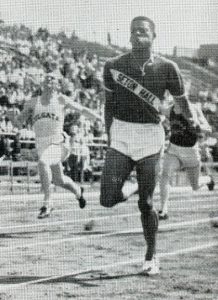Seton Hall University has a long and memorable historical connection to a number of Summer Olympiads over the last several decades. International appearances by Setonia track stars date back to the appearance of Mel Dalton who competed in the 3,000-meter Steeplechase at the 1928 Amsterdam Games through the success exhibited by Andrew Valmon who earned gold medals as a part of the United States 4×400 meter relay team at both the 1988 Seoul and 1992 Barcelona Games respectively. Numerous track and field stars have also made their mark at the school, but one individual, Andy Stanfield has been hailed by many coaches and fans as one of the most successful sprinters to ever represent the Pirates by virtue of his three Olympic medals earned during the early 1950s.
Andrew “Andy” William Stanfield was born on December 29, 1927 in Washington, D.C. and grew up in Jersey City. Stanfield later attended Lincoln High School in Hudson County where he was the City, District, and New Jersey State Champion in the 220 yard dash and Broad Jump. Following a post-graduation stint in the U.S. Army as a radio repairman, in the South Pacific During World War II, Stanfield enrolled at Seton Hall during the Fall of 1948.
Stanfield, who majored in Education and pledged as part of the Alpha Phi Alpha fraternity during his first year on campus also became a member of the Track & Field team as a freshman. As a means of sharpening his talents, Stanfield was coached by former Olympian Johnny Gibson who helped the freshman become a premier hurdler and long jumper in addition to developing him into a world class sprinter.

Stanfield began racking up several national titles over the next few years, winning six American Amateur Union (AAU) championships (1949: 100 and 200 meters; 1950: 60 yards; 1951: long jump; 1952: 200 meters; 1953: 220 yards) and eight of nine sprint titles during various Intercollegiate Association of Amateur Athletes of America (1C4A) at both indoor and outdoor meet competitions.
This success caught the attention of the press, where Arthur Daley of the New York Times was the first to provide wide-spread coverage of Stanfield as published in this account from June of 1950:
“The Title of ‘World’s Fastest human’ is not hereditary as is that of the House of Windsor . . . undoubtedly it is safe to take a peek at the current holder of same. He is Andy Stanfield of Seton Hall who has rocketed from nowhere in little more than a year . . . with the silken stride . . . Handy Andy has covered the 100 in 9.4 . . . his style is what is most eye-catching . . . He doesn’t run. He flows!”

Shortly after graduating from Seton Hall in 1952 as a world record holder in the 200 meters, Stanfield became an Olympic champion in this event at the 1952 Helsinki Games along with adding a second gold medal as part of the 4×100 meter relay team. Further success came with a silver medal in the 200 meters at the Melbourne Olympic Games of 1956.
Post-competition, Stanfield became Director of Intramural Athletics at Seton Hall in 1953. He later returned to Jersey City and joined the Board of Education as a Physical Education Teacher and was YMCA coordinator at day camps during the mid-1950s. Stanfield later became Athletic Coordinator for Public Schools throughout Jersey City. He also branched out into the computer field where he started training schools in Northern New Jersey along with holding membership on various civic service boards including a stint as Chair of the Director of the Newark Area Redevelopment Council.
Stanfield also never forgot his athletic career as he was a track announcer and analyst for WPIX-TV during the 1960s and participation in Master Level Track and Field meets prior to his induction to the National Track and Field Hall of Fame in 1977. Stanfield passed away in Livingston, New Jersey at the age of 57, but his legacy is not forgotten.

Documentation related to the accomplishments of Andy Stanfield in the form of match results, meet programs, runner profiles, and other information are included within the University Archives section of the Monsignor William Noé Field Archives & Special Collections Center. Included are references within the Seton Hall University Athletics & Recreation Collection under the Seton Hall University Athletic Hall of Fame as a Charter Member (1973-74) along with the Track and Field Collection dating between 1948-53. A link to the site can be found here – https://archivesspace-library.shu.edu/repositories/2/resources/420
Articles can also be found within the school newspaper, The Setonian between 1948-53 which is available to our research community via microfilm. In addition, Andy Stanfield is featured in various Seton Hall University Yearbooks (The Galleon) during the same time period which are available digitally via the following link – https://scholarship.shu.edu/yearbooks/index.3.html
If you have questions, wish to find more information, or set up an appointment to learn more about Andy Stanfield, or any aspect of University History please feel free to contact us via e-mail at: <archives@shu.edu> or by phone at: (973) 761-9476.
Works Cited
Andy Stanfield. International Olympic Committee Biography. Accessed 22 February 2022, https://olympics.com/en/athletes/andrew-william-stanfield
Daley, Arthur. “The World’s Fastest Human Four for Four,” New York Times, 35, 16 June 1950.
First Annual Seton Hall University Athletic Hall of Fame Enshrinement Dinner Program, 1 June 1973. South Orange, NJ: Seton Hall University.
The Setonian (Seton Hall Student Newspaper), January 1, 1948-December 31, 1952, Vols. XXIII-XXVIII. South Orange, NJ: Seton Hall University. [* Individual issues can be provided for further reference upon request]
Cunningham, Thomas W. The Summit of a Century: The Centennial Story of Seton Hall University, 1856-1956. South Orange, NJ: Seton Hall University, 1956.
The Galleon (Seton Hall Student Yearbook), 1948-1952. South Orange, NJ: Seton Hall University.
